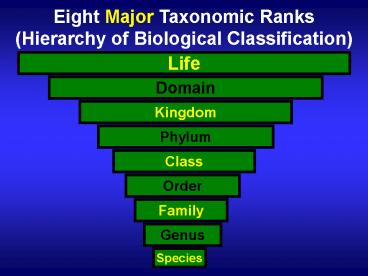Eight Major Taxonomic Ranks (Hierarchy of Biological Classification) PowerPoint PPT Presentation
1 / 19
Title: Eight Major Taxonomic Ranks (Hierarchy of Biological Classification)
1
Eight Major Taxonomic Ranks (Hierarchy of
Biological Classification)
Life
Domain
Kingdom
Phylum
Class
Order
Family
Genus
Species
2
Eukarya Domain
(Protista Kingdom)
3
Protista Kingdom
(Three Main Groups)
Pseudopods
Cilia
Animal Like
Flagella
Sporozoans
also called Protozoans
One celled Algae
Plantlike
Multi-celled Algae
Slime Mold
Fungus-like
Water Mold
4
Eukarya Domain (Fungi
Kingdom)
Mold
Mushroom
Lichen
Most fungi use spores to reproduce and need
moist, warm places to grow.
5
Eukarya Domain (Plantae
Kingdom)
Plants produce their food through photosynthesis.
Plant cells with visible chloroplasts.
6
Plantae Kingdom (Three
Main Groups)
Seedless and Seed Producing
Ferns
Gymnosperms
Vascular
Angiosperms
Most species are single-celled
Green Algae
Mosses
Non-Vascular
7
Eukarya Domain
(Animalia Kingdom)
Invertebrates
Vertebrates
- 95 of all animal species
- 3/4 of all animals are from the arthropod species
- Fish have majority number of vertebrate species.
8
Animalia Kingdom (2
Major Phylums)
Vertebrates
Invertebrates
Chordata
Fish
Arthropod
Reptiles
Birds
Worms
Mollusk
Amphibians
Cnidaria
Sponges
Mammals
Echinoderm
9
The word animal comes from the Latin word for
having breath.
AnimalsRelativeNumbers.png
10
Invertebrate Phylum (Major
Classes)
insects
Arthropod
arachnids
snails
crustaceans
Mollusk
squid
segmented
clams
Worms
nematodes
starfish
flatworms
Echinoderm
sea urchin
coral
sand dollar
Cnidaria
jellyfish
Sponges
sea anenomes
11
Vertebrate Phylum
(Major Classes)
frogs
Amphibians
salamanders
cartilage (sharks/rays)
caecilian
Fish
crocodile
bony
Reptiles
lizard/snake
turtle
monotremes
small
Mammals
marsupials
Birds
large (ostriche)
placentals
Tetrapoda (four legged) animals
12
All members have a cranium, a skull
Amphibians
Reptiles
Fish
Birds
Mammals
13
Mammal Class
(Three Main Groups or Subclasses)
Lay eggs
Monotremes
Pouched
Marsupials
Placenta developed from fetus
Placentals
Every young mammal is fed with milk produced in
its mothers body.
14
(No Transcript)
15
Mammal Class (Placental
Subclass)
largest orders
Rodent
Bats
prosimian
Primate
simian
Shrews
Feliformia
Carnivora
Caniformia
whales
even-toed
Cetacea
Ungulates
dolphins
odd-toed
porpoises
16
Mammal Class (Placental
Subclass)
Placenta is an organ in pregnant female mammals
that helps to feed the offspring during
gestation, before birth.
17
Placental Subclass
(Primate Order)
Lemurs
Galagos
Apes
Monkeys
Gibbons
Human
Tarsiers
Simian
Prosimian
18
Hominidae Family (Homo
sapien Species)
- Homosapien means wise man or knowing man.
- Have highly developed brains capable of abstract
reasoning, language, introspection, and problem
solving. - Adept at self-expression, exchange ideas, and
organization. - Create complex social structures with variety of
values, social norms, and rituals.
19
Hominidae Family (Homo
sapien Species) (cont)
- Only species known to build fires, cook their
food, clothe themselves, and use numerous other
technologies. - Capable of full bipedal location.
- Human brain is more intelligent than any other
species.

